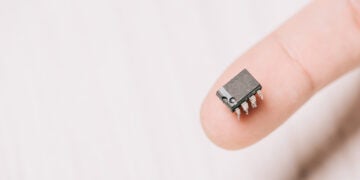
Engineers working on a 3D CAD model of an engine.
CAD neutral environments provide opportunities for seamless collaboration and interoperability across diverse CAD software platforms, facilitating efficient exchange of design data throughout the product lifecycle. By adopting CAD neutral file formats and interoperability standards, companies can facilitate smoother communication and reduce errors and redundancies in the design process. Through this process, innovation can be enhanced, product development cycles accelerated, and market responsiveness increased. Embracing CAD neutral environments enables businesses to streamline workflows, improve efficiency, and unlock new collaborative design and engineering possibilities. Below is a list of the top CAD neutral file formats and their advantages and disadvantages.
Top CAD File Formats
The most used CAD neutral file formats among engineers; include the following.
|
TOP CAD NEUTRAL FILE FORMATS: ADVANTAGES AND DISADVANTAGES |
|||
|
CAD Neutral Format |
Description |
Advantages |
Disadvantages |
|
STEP (Standard for the Exchange of Product Data) |
ISO standard for the computer- interpretable representation and exchange of product manufacturing information |
– Comprehensive support for geometry, assembly structure, and metadata – Allows for precise representation of CAD data |
– Can result in large file sizes – Complex data structure may require significant processing power to interpret |
|
IGES (Initial Graphics Exchange Specification) |
Older neutral file format used for exchanging 2D and 3D CAD data between different systems |
– Widely supported across CAD software – Allows for basic exchange of 2D and 3D geometry |
– Limited support for complex geometry and metadata – Prone to data loss and inaccuracies during translation |
|
STL (Stereolithography) |
File format used for representing surface geometry of 3D models |
– Simple and widely supported for 3D printing applications |
– Limited to surface geometry representation without support for assemblies or metadata – Cannot represent curved surfaces accurately |
|
Parasolid |
Geometric modeling kernel used in many CAD systems |
– Powerful geometric modeling kernel used in many CAD systems – Provides a neutral file format for exchanging precise 3D geometry |
– Requires licensing or access to Parasolid-based CAD software for full functionality – May not fully capture design intent or assembly structure |
|
JT (Jupiter Tessellation) |
Format developed by Siemens PLM Software for representing 3D data in lightweight, highly compressed files |
– Lightweight and highly compressed format for 3D data – Retains full product structure, geometry, and PMI (Product and Manufacturing Information) – Supports tessellation for visual fidelity |
– Requires specific software for authoring and viewing JT files – Limited adoption compared to other formats |
|
OBJ (Wavefront OBJ) |
Text-based file format for representing 3D geometry, materials, and texture information |
– Simple and widely supported for 3D graphics applications – Supports geometry, materials, and texture information |
– Limited to surface geometry representation without support for assemblies or metadata – Text-based format can result in larger file sizes |
|
DXF (Drawing Exchange Format) |
File format developed by Autodesk for exchanging CAD drawings between different CAD software |
– Widely supported for exchanging 2D CAD drawings – Simple text-based format for interoperability |
– Limited support for 3D geometry and metadata – Prone to data loss and inaccuracies during translation |
|
COLLADA (Collaborative Design Activity) |
XML-based file format for exchanging digital assets between different graphics software applications |
– XML-based format supporting 3D geometry, materials, animations, and more – Designed for interoperability between different graphics software applications |
– XML structure can result in larger file sizes compared to binary formats – Limited adoption in some CAD workflows |
These advantages and disadvantages can influence the choice of the CAD neutral file format based on compatibility, required features, file size considerations, and intended use cases.
Role of CAD Neutral Libraries in PCBA Design
CAD neutral libraries store design data in formats that can be accessed and utilized by various CAD software platforms without losing critical information. These libraries streamline data exchange between different software tools, ensuring compatibility and interoperability during design flow.
In addition, CAD neutral libraries play several key roles in 3D/2D integration:
- Store 3D models, 2D drawings, and related data in standardized formats like those listed in the table above. The files are organized with metadata tagging and version control, making locating and retrieving data easy for designers.
- Promote interoperability between different CAD software platforms for designing electromechanical products by providing a standard format for data exchange. Designers can import and export data from the library into their preferred CAD tools without compatibility issues.
- Facilitate the conversion and translation process between 3D and 2D representation with tools that preserve critical design information such as dimensions, annotations, and geometric features.
- Ensure the integrity and quality of design data during conversion and translation. Designers can validate the accuracy of 2D drawings generated from 3D models and vice versa, identifying and resolving any discrepancies or errors.
- Maintain version control and revision management capabilities, allowing designers to track changes to design data over time.
- Serve as repositories for documentation and collaborative annotations, enabling designers to add comments, instructions, or feedback directly to the design data.
Overall, CAD neutral libraries play a critical role in facilitating 3D/2D integration by providing a centralized repository for design data in formats compatible with different CAD software platforms. They streamline data exchange, promote interoperability, ensure version control and quality assurance, and support collaboration among designers, ultimately enhancing efficiency and productivity in the design workflow.
If you’re looking for CAD models for common components or CAD neutral file formats, Ultra Librarian helps by compiling all your sourcing and CAD information in one place.
Working with Ultra Librarian sets up your team for success to ensure streamlined and error-free design, production, and sourcing. Register today for free.








